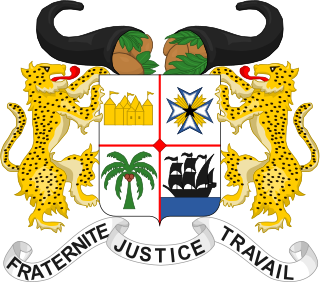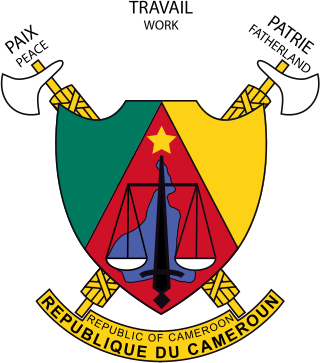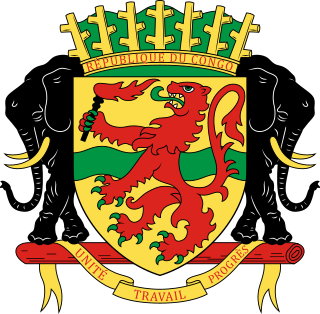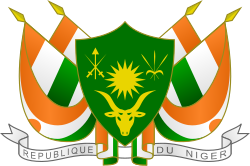
The coat of arms of South Africa is the main heraldic insignia of South Africa. The present coat of arms was introduced on Freedom Day, 27 April 2000, and was designed by Iaan Bekker. It replaced the earlier national arms, which had been in use since 1910. The motto is written in the extinct |Xam, member of the Khoisan languages, and translates literally to "diverse people unite". The previous motto, in Latin, was Ex Unitate Vires, translated as "From unity, strength".

A saltire, also called Saint Andrew's Cross or the crux decussata, is a heraldic symbol in the form of a diagonal cross. The word comes from the Middle French sautoir, Medieval Latin saltatoria ("stirrup").

The coat of arms of Quebec was adopted by order-in-council of the Government of Quebec on 9 December 1939, replacing the arms assigned by royal warrant of Queen Victoria on 26 May 1868.

The national flag of Ivory Coast is a tricolor flag consisting of equal bands of orange, white, and green. The proportions of the flag are 2:3. It is the national emblem of the Republic of Ivory Coast as affirmed in Article 29 of the Constitution of Ivory Coast in 1960.

The coat of arms or national seal of Benin, originally introduced in 1964, was readopted in 1990 after being replaced in 1975.

The flag of Haiti is the national flag of the Republic of Haiti. It is a bicolour flag featuring two horizontal bands coloured blue and red, emblazoned by a white rectangular panel bearing the coat of arms of Haiti. The coat of arms depicts a trophy of weapons atop a green hill and a royal palm symbolizing independence. The palm is topped by the Cap of Liberty. The motto L'Union fait la Force appears on a white ribbon below the arrangement.

The coat of arms of Burundi, adopted in 1966, consists of a shield surrounded by three spears. On the shield is the motto of the nation, as well as the head of a lion. Behind the shield there are three crossed traditional African spears. Under the shield the national motto of Burundi appears on a scroll: Unité, Travail, Progrès.

The coat of arms of Cameroon consists of a shield with a banner above and below it. Behind the shield are two crossed fasces. The shield has the same color pattern as the flag of Cameroon, and in the center is a map of the nation. The scales of justice are superimposed on top of the map of the nation since 1984.

The coat of arms of the Republic of the Congo has a shield with a rampant red lion holding a torch. The background color of the shield is gold with a green, wavy, horizontal stripe along the middle. A golden crown sits above the shield. Two large African war elephants support the shield. A banner with the national motto "Unité Travail Progrès" is draped from a bar supporting the war elephants. The arms were adopted in 1960 and readopted in 1991 after having been replaced with a simpler, unheraldic symbol during the People's Republic of the Congo era from 1970–1991.

The coat of arms of Ivory Coast in its current form was adopted in 1964. The focal point of the emblem is the head of an elephant. The elephant is symbolically important to the nation, since it is the largest animal found in Ivory Coast as well as being the source of ivory for which the nation is named. The rising sun is a traditional symbol of a new beginning. Below the elephant head is a banner containing the name of the nation.

The coat of arms of France depicts a lictor's fasces upon branches of laurel and oak, as well as a ribbon bearing the national motto of Liberté, égalité, fraternité. The full achievement includes the star and grand collar of the Legion of Honour. This composition was created in 1905 by heraldic painter-engraver Maurice de Meyère, and has been used at the Foreign Ministry during state visits and for presidential inaugurations.

The current coat of arms of Zimbabwe was adopted on 21 September 1981, one year and five months after the national flag was adopted. Previously the coat of arms of Zimbabwe was identical to the former coat of arms of Rhodesia.

The first coat of arms of Montreal was designed by Jacques Viger, the first mayor of Montreal, and adopted in 1833 by the city councillors. Modifications were made some one hundred five years later and adopted on 21 March 1938, and again on 13 September 2017, resulting in the version currently in use. The coat of arms was the only city emblem representing Montreal until 1981, when a stylized logo was developed for common daily use, reserving the coat of arms for ceremonial occasions.
In British heraldry, vert is the tincture equivalent to green. It is one of the five dark tinctures called colours.

Santa Rosa de Cabal is a town and municipality in the Department of Risaralda, Colombia. About 14 km away from the capital Pereira. In 2023 the town had an estimated population of 79,840.

The coat of arms of Togo was adopted on 14 March 1962. Since this Togolese national symbol does not follows the rules of heraldry for a traditional coat of arms, then it could be considered a national emblem instead.

The coat of arms of Kenya features two lions, a symbol of protection, holding spears and a traditional East African shield. The shield and spears symbolize unity and defence of freedom. The shield contains the national colours, representing:

French heraldry is the use of heraldic symbols in France. Although it had a considerable history, existing from the 12th century, such formality has largely died out in France, as far as regulated personal heraldry is concerned. Civic heraldry on the other hand remains a visible part of daily life.

National symbols of France are emblems of the French Republic and French people, and they are the cornerstone of the nation's republican tradition.

The coat of arms of Marseille has witnessed its existence since the 14th century. The current version was adopted in 1883.






















